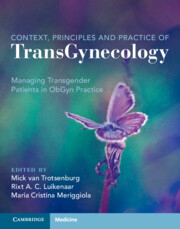Book contents
- Context, Principles, and Practice of Transgynecology
- Context, Principles, and Practice of Transgynecology
- Copyright page
- Dedication
- Contents
- Foreword
- Preface
- Contributors
- Abbreviations
- Section A Contextual Transgynecology
- Section B Practicing Transgynecology
- Section C Gynecological Surgery for Transgender Males
- Section D Sexuality and Contraception
- Section E Fertility and Reproduction
- Section F Impact of Gender-affirming Hormonal Therapy on Genital Organs
- Section G Screening and Prophylaxis
- Chapter 34 Prevention and Management of Neovaginal Stenosis and Other Related Complications of Vaginoplasty
- Chapter 35 Pelvic Physical Therapy for Gender-affirming Genital Vaginoplasty
- Chapter 36 HPV-associated Dysplasia of Skin and Mucosa and Vaccination Options in Trans People
- Chapter 37 Extent, Burden, and Characteristics of STDs and HIV in Trans People
- Chapter 38 Screening Policies for Cervical, (Neo-)Vaginal, and Vulvar Dysplasia and Cancer
- Transgynecology Index
- References
Chapter 34 - Prevention and Management of Neovaginal Stenosis and Other Related Complications of Vaginoplasty
from Section G - Screening and Prophylaxis
Published online by Cambridge University Press: 22 December 2022
- Context, Principles, and Practice of Transgynecology
- Context, Principles, and Practice of Transgynecology
- Copyright page
- Dedication
- Contents
- Foreword
- Preface
- Contributors
- Abbreviations
- Section A Contextual Transgynecology
- Section B Practicing Transgynecology
- Section C Gynecological Surgery for Transgender Males
- Section D Sexuality and Contraception
- Section E Fertility and Reproduction
- Section F Impact of Gender-affirming Hormonal Therapy on Genital Organs
- Section G Screening and Prophylaxis
- Chapter 34 Prevention and Management of Neovaginal Stenosis and Other Related Complications of Vaginoplasty
- Chapter 35 Pelvic Physical Therapy for Gender-affirming Genital Vaginoplasty
- Chapter 36 HPV-associated Dysplasia of Skin and Mucosa and Vaccination Options in Trans People
- Chapter 37 Extent, Burden, and Characteristics of STDs and HIV in Trans People
- Chapter 38 Screening Policies for Cervical, (Neo-)Vaginal, and Vulvar Dysplasia and Cancer
- Transgynecology Index
- References
Summary
Neovaginal stenosis is one of the most reported complications of vaginoplasty. In this chapter, we review methods to prevent this complication during penile inversion vaginoplasty and the potential use of experimental techniques like biomaterials to avoid its development. Surgical and nonsurgical repair options are outlined for patients who experience neovaginal stenosis after vaginoplasty, as well as solutions to other potential postoperative complications that can arise after the procedure. These include dehiscence, postoperative bleeding, fistula formation, urinary symptoms, unique complications following intestinal vaginoplasty, and chronic pain.
Keywords
- Type
- Chapter
- Information
- Context, Principles and Practice of TransGynecologyManaging Transgender Patients in ObGyn Practice, pp. 251 - 260Publisher: Cambridge University PressPrint publication year: 2022



